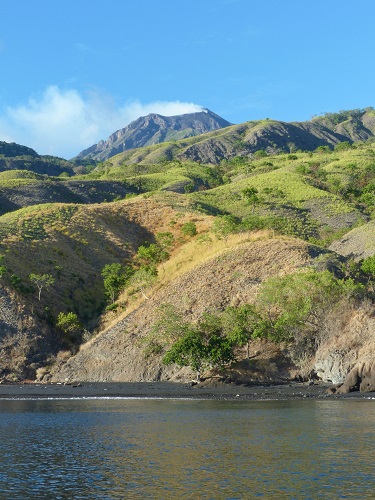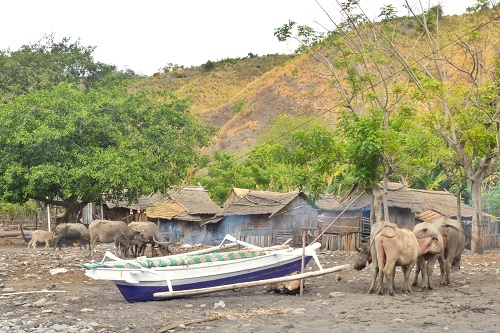The rugged peak of Sangeang Api rose above the trees and dry grass that dominated the lower slopes. Clouds of white steam billowed from the crater. Even when diving, we could hear constant rumbling deep within the bowels of the volcano. However, despite the prolific volcanic activity, this island is inhabited. We took a walk through Bontoh village, a tiny settlement by the beach.
Bontoh Village Beach
Crunching across black sand and stones, we headed towards the village. Simple outrigger canoes littered the beach. Painted in bright greens, yellows and blues, these are the local fishing boats of choice. On one side, a handful of goats trotted about appearing to keep an eye on the fast-approaching rain clouds. On the other, there stood a small herd of water buffalo interspersed with the odd chicken. Children played on the beach too but were so engrossed in their games that they didn't seem to notice our arrival.
A woman appeared by the tree line and came over to meet us. As the only word all three of us could understand was 'Hello', our conversation was short. She did smile a lot though. Her gums were stained beetroot red and her few remaining teeth were black.

Sangeang Api Volcano
The Villagers' Big Construction Project
From our boat, we had noticed a scaffold towering above the rest of Bontoh village. We went over for a closer look. Full-sized trees had been lashed together with planks of wood and bamboo and topped with a roof of palm fronds. In the midst of this framework, there seemed to be an ark.

Goats On The Beach
We learned that the villagers were building a boat so they could travel further afield to trade with different islands. Invited to look inside the vessel we took turns scrambling up a very long and narrow plank of wood. From our vantage point at the top of the hull, we could see the inside of the boat was completely empty. As soon as more wood arrived from Flores however, the construction would continue.
The Residents Of Bontoh Village
We wandered between the houses, small square shacks cobbled together from a mishmash of wood and rusty corrugated iron, each with a thatched roof. Many of the villagers greeted us or waved, one stretching her arm out next to mine as she marvelled at my milky white skin. The encounter left a dirty streak on my arm, some of the black volcanic sand on which Bontoh village is built.

Houses In Bontoh Village
One of our group got a little snap happy, pushing his rather large camera into the faces of a few of the villagers. He ignored the first woman's cry of “No, no, no” so with a raucous “Wheeee”, the next lady pulled up her skirt. He took the hint and withdrew.
Why Visit Bontoh Village?
Bontoh village has no piped water, no shops and no amenities. What they do have though, is a world-class muck diving site just off their beach. As with several places we dived around Komodo National Park, the villagers accept regular donations from visiting dive boats. In exchange, they agree not to fish on the dive sites. The residents of Bontoh village have no use for money so instead we gave them a care package of noodles and other essentials. And we enjoyed a spectacular night dive right on their doorstep.

